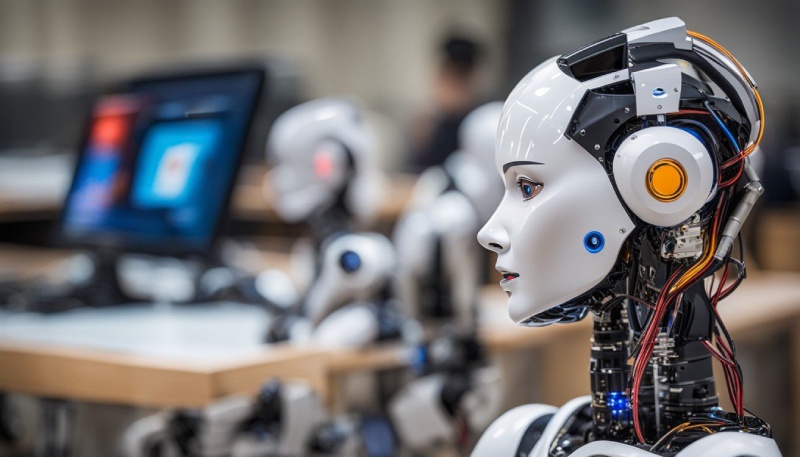In the realm of Artificial Intelligence (AI), the journey from theory to practical application is a thrilling endeavor. Mini projects serve as stepping stones, offering students a hands-on exploration into the fascinating world of AI. These bite-sized ventures not only hone technical skills but also ignite creativity and problem-solving prowess, setting the stage for deeper immersion into AI’s vast domains.
Why Mini Projects?
Mini projects stand as the bedrock for budding AI enthusiasts, offering a playground to experiment, innovate, and apply theoretical concepts. They provide a tangible avenue to bridge the gap between theory and practice, enabling students to grasp AI fundamentals while nurturing a spirit of exploration.
What to Expect?
These mini projects span diverse domains within AI, from machine learning and natural language processing to computer vision and robotics. Each project presents a unique challenge, encouraging students to leverage AI techniques, algorithms, and tools to solve problems, build models, or create AI-driven applications.
The Journey Ahead
The exploration of mini projects for AI students isn’t merely about coding; it’s a journey of discovery. It cultivates resilience, fosters curiosity, and fuels a passion for innovation. These projects serve as the launchpad, propelling students towards larger, more intricate AI endeavors and empowering them to shape the future through the transformative potential of Artificial Intelligence.
Join us in this immersive AI expedition, where mini projects become the building blocks for a captivating journey into the heart of intelligence-driven technologies.
Speaker Recognition Implementation with Different Python Tools
Face Similarity With Python Moduels & Deep Learning
Top 10 Mini Projects For AI Students
Here are ten mini projects tailored for AI students that cover various domains within artificial intelligence:
1. Sentiment Analysis on Social Media Data:
Sentiment Analysis on Social Media Data involves the application of Natural Language Processing (NLP) techniques to decipher, categorize, and analyze the sentiments expressed within textual content on various social media platforms. By utilizing machine learning algorithms, text processing, and language analysis, this process aims to determine the emotional tone, opinions, or attitudes conveyed in user-generated posts, comments, or messages. The goal is to classify the sentiments as positive, negative, or neutral, enabling insights into public opinion, brand perception, trends, or user sentiments on specific topics or products. This analysis often involves preprocessing text data, feature extraction, and employing classification models to discern and quantify the sentiment polarity embedded in the textual content across social media channels.
2. Handwritten Digit Recognition:
Handwritten Digit Recognition is a task within the domain of image classification where machine learning models are designed to accurately identify and distinguish numerical digits handwritten on images or documents. Employing techniques from computer vision and deep learning, this process involves training algorithms on datasets like the MNIST dataset, teaching them to recognize patterns and features associated with handwritten digits. Leveraging neural network architectures, particularly Convolutional Neural Networks (CNNs), these models learn to identify and classify digits ranging from 0 to 9 with high accuracy. Handwritten Digit Recognition holds significance in various applications, including optical character recognition (OCR), digitizing handwritten notes, and automating data entry processes in digitized documents.
3. Chatbot Development:
Chatbot Development involves the creation of conversational agents or automated systems capable of understanding natural language inputs and providing relevant and contextually appropriate responses to user queries or commands. Using Natural Language Processing (NLP) techniques, machine learning, and sometimes rule-based systems, chatbots are trained on datasets or designed to interact with users in a conversational manner. These bots can handle various tasks, including answering questions, providing assistance, guiding users through processes, or executing specific actions based on user inputs. Chatbot Development typically involves designing dialogue flows, integrating with backend systems or APIs for information retrieval, and employing algorithms to understand and generate human-like responses, contributing to improved user experiences and efficient customer service across diverse industries.
4. Prediction of Stock Market Trends:
Prediction of Stock Market Trends involves the application of statistical and machine learning techniques to analyze historical market data and make forecasts about future price movements or trends in financial markets. Utilizing algorithms such as regression analysis, time series forecasting, or machine learning models, this process aims to identify patterns, trends, or indicators within historical stock market data to predict potential future movements in stock prices or market indices. By analyzing factors like historical prices, trading volumes, technical indicators, and fundamental data, these models attempt to provide insights for investors or traders to make informed decisions about buying, selling, or holding stocks. However, predicting stock market movements accurately remains a challenging task due to the complexity of market dynamics and the influence of various unpredictable factors.
5. Facial Expression Recognition:
Facial Expression Recognition involves the use of computer vision and machine learning techniques to detect, analyze, and categorize human emotions based on facial expressions captured in images or videos. Using deep learning models, particularly Convolutional Neural Networks (CNNs), this process identifies facial landmarks and features, extracting key information such as eyebrow position, eye shape, mouth movements, and overall facial configurations to discern emotions like happiness, sadness, anger, surprise, or disgust. By training models on datasets containing labeled facial expressions, these systems learn patterns and correlations between facial features and emotions, enabling accurate classification of emotional states expressed through human faces. Facial Expression Recognition finds applications in fields such as human-computer interaction, sentiment analysis, affective computing, and improving human-machine interfaces.
6. Spam Email Detection:
Spam Email Detection involves the use of machine learning and natural language processing (NLP) techniques to differentiate between spam (unsolicited or undesirable) emails and legitimate messages in an email system. By leveraging algorithms like Naive Bayes, Support Vector Machines (SVM), or neural networks, this process analyzes the content, structure, and metadata of emails to identify patterns or characteristics indicative of spam. Features such as the presence of specific keywords, email headers, sender information, and textual analysis are employed to classify incoming emails into spam or non-spam categories. Through the learning from labeled datasets, these models become adept at recognizing common spam traits, allowing email systems to automatically filter out unwanted messages, reducing the risk of phishing, malware, or irrelevant content reaching users’ inboxes.
7. House Price Prediction:
House Price Prediction involves the development of machine learning models to estimate or forecast the selling or listing prices of residential properties based on various features or attributes. Using regression algorithms, these models analyze historical housing data, considering factors such as location, square footage, number of bedrooms/bathrooms, amenities, neighborhood characteristics, and property age to predict the market value of houses. By training on datasets containing both the property features and their corresponding sale prices, these models learn relationships and correlations, enabling them to make predictions about the selling price of new or unseen properties. House Price Prediction models are valuable tools for real estate professionals, buyers, and sellers, aiding in decision-making, investment strategies, and property valuation.
8. Recommendation System:
A Recommendation System is an information filtering system that predicts or suggests items, products, or content that users might be interested in based on their preferences, historical behavior, or similarities to other users. These systems leverage machine learning algorithms and collaborative filtering techniques to analyze user interactions, preferences, and item attributes to generate personalized recommendations. They can be categorized into collaborative filtering (based on user behavior or preferences) or content-based filtering (using item attributes). Recommendation systems find applications in various domains, such as e-commerce platforms, streaming services, social media, and more, enhancing user experiences by delivering personalized and relevant suggestions, thereby increasing user engagement and satisfaction.
9. Hand Gesture Recognition:
Hand Gesture Recognition involves the utilization of computer vision techniques to interpret and classify hand movements and configurations captured through image or video data. Using methods like image processing, feature extraction, and machine learning algorithms, particularly Convolutional Neural Networks (CNNs) or custom classifiers, this process identifies and understands the gestures made by hand poses or movements. By analyzing spatial relationships, contours, or key points in the hand region, these systems discern and categorize various gestures, enabling interactions, commands, or communications through hand movements. Hand Gesture Recognition finds applications in sign language interpretation, human-computer interaction, augmented reality interfaces, and remote control systems, facilitating intuitive and natural interactions between users and devices.
10. Traffic Sign Recognition:
Traffic Sign Recognition involves the application of computer vision and machine learning techniques to detect, classify, and interpret traffic signs from images or video feeds captured by cameras mounted on vehicles or traffic systems. Using deep learning models, particularly Convolutional Neural Networks (CNNs), this process identifies and categorizes various traffic signs, such as speed limits, stop signs, yield signs, and directional indicators. By analyzing visual features, shapes, colors, and symbols within the captured images, these systems recognize and interpret traffic signs, aiding in real-time decision-making for vehicle navigation, driver assistance systems, or autonomous vehicles. Traffic Sign Recognition enhances road safety, assists drivers, and contributes to the development of intelligent transportation systems by providing automated recognition and interpretation of crucial traffic regulations and warnings.
These mini projects offer students an opportunity to apply AI concepts, experiment with various algorithms, and gain practical experience in different domains of artificial intelligence. They can be adapted or expanded upon based on students’ interests, available datasets, and complexity levels desired.
Conclusion
In the realm of Artificial Intelligence (AI), engaging in a diverse array of mini projects stands as a pivotal gateway for students venturing into the captivating world of intelligent technologies. These ten mini projects, spanning sentiment analysis, image recognition, financial forecasting, and more, serve as rich learning opportunities. Each project offers a chance to dive into practical applications, employing machine learning algorithms, natural language processing techniques, and computer vision methodologies. By embarking on these projects, students not only refine their technical skills but also foster problem-solving acumen, critical thinking, and creativity. These mini projects symbolize the stepping stones into a realm brimming with innovation, where AI becomes more than a theoretical concept—it becomes a tangible tool to decipher sentiments, recognize patterns, predict trends, and enhance human experiences across various domains. As students engage in these endeavors, they pave the way for a future where AI’s transformative potential is unlocked through their expertise, curiosity, and dedication to mastering the intricacies of intelligent systems.








